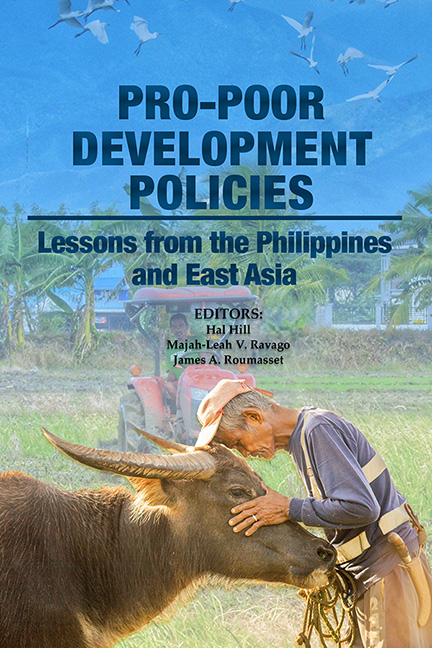Book contents
- Frontmatter
- Dedication
- Contents
- Figures, Tables and Boxes
- Foreword
- Foreword
- Message
- Preface and Acknowledgements
- About the Editors
- About the Contributors
- Acronyms
- Part 1 Introduction and Synthesis
- Part 2 Agricultural and Economic Development
- Part 3 Economic Policies for Achieving Targeted Levels of Living in the Philippines
- Part 4 Inequality and Economic Development
- Part 5 Competition Law and Policy
- Part 6 International Dimensions
- Index
18 - Adopting and Adapting Competition Policy: Asian Illustrations
Published online by Cambridge University Press: 09 January 2024
- Frontmatter
- Dedication
- Contents
- Figures, Tables and Boxes
- Foreword
- Foreword
- Message
- Preface and Acknowledgements
- About the Editors
- About the Contributors
- Acronyms
- Part 1 Introduction and Synthesis
- Part 2 Agricultural and Economic Development
- Part 3 Economic Policies for Achieving Targeted Levels of Living in the Philippines
- Part 4 Inequality and Economic Development
- Part 5 Competition Law and Policy
- Part 6 International Dimensions
- Index
Summary
INTRODUCTION
Competition disciplines firms to subjugate other objectives to the pursuit of profits, thereby enhancing market efficiency. In his Wealth of Nations, Adam Smith (2008) describes competition as the “exercise of allocating productive resources to their most highly valued uses and encouraging efficiency”. Competition can also incentivize product variety and prices, thus enhancing consumer welfare. Moreover, it plays an important role in encouraging innovation, increasing productivity and propelling growth, thereby promoting a country’s sustained economic development.
Effective competition does not necessarily follow from the mere existence of many competing firms, however. Inappropriate government policies and firm conduct can impair competition and hinder its role in economic development. Weak institutions and rent-seeking by special interests may inhibit competition-enhancing reforms, restrict opportunities for innovation and diminish consumer welfare. This is where competition policy plays a role. Competition policy encompasses competition advocacy as well as laws and regulations concerning anticompetitive behaviour and production structures (Motta 2004). Competition law is a set of enforceable legal rules designed to prevent the abuse of market dominance and anticompetitive behaviour and to break down barriers to entry. Competition advocacy promotes a culture of competition as well as consumer interests (Clark 2005; Rakić 2018). Since effective competition can improve income distribution as well as innovation and productivity, competition policy can be critical in achieving inclusive growth and sustained development.
To investigate the impact of the adoption of competition law on long-term economic growth, we constructed a cross-country data set from 1975 to 2015. Countries may choose to adopt—or not adopt— competition law depending on their circumstances, including level of economic development, institutions and geography. Considering endogeneity and self-selection, we employ an endogenous switching regression, allowing for the interdependence of economic growth and adoption of competition law. Our analysis shows that adoption increased the growth rates in adopting countries but would have decreased growth in non-adopting countries.
In addition to correcting the abuses of anticompetitive behaviour, competition policy should be designed to promote innovation and productivity growth and be well coordinated with trade and domestic policies. We review these arguments, focusing on Asian countries. While the design and organization of competition authorities in Asia vary according to each country’s historical and economic situation, we focus on South Korea, Thailand and the Philippines to capture the characteristics of the competition law and authorities at various stages of maturity.
- Type
- Chapter
- Information
- Pro-poor Development PoliciesLessons from the Philippines and East Asia, pp. 495 - 545Publisher: ISEAS–Yusof Ishak InstitutePrint publication year: 2022



